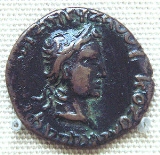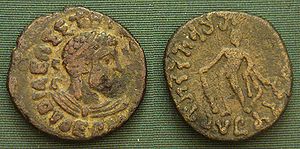
Kujula Kadphises
Encyclopedia

Kujula Kadphises, reigned (30–80 CE) (Kushan language: Κοζουλου Καδφιζου, also Κοζολα Καδαφες, Pali
Páli
- External links :* *...
: Kujula Kasasa, Ancient Chinese:丘就卻, Qiujiuque) was a Kushan prince who united the Yuezhi
Yuezhi
The Yuezhi, or Rouzhi , also known as the Da Yuezhi or Da Rouzhi , were an ancient Central Asian people....
confederation during the 1st century CE, and became the first Kushan emperor. According to the Rabatak inscription
Rabatak inscription
The Rabatak inscription is an inscription written on a rock in the Bactrian language and the Greek script, which was found in 1993 at the site of Rabatak, near Surkh Kotal in Afghanistan...
, he was the grandfather of the great Kushan king Kanishka I
Kanishka
Kanishka ) was an emperor of the Kushan Empire, ruling an empire extending from Bactria to large parts of northern India in the 2nd century of the common era, and famous for his military, political, and spiritual achievements...
.
History
The origins of Kujula Kadphises are quite obscure, and it is usually considered he was a descendant of the Kushan ruler HeraiosHeraios
Heraios was a clan chief of the Kushans , one of the five constituent tribes of the Yuezhi confederacy in Bactria in the early 1st century CE, roughly at the time when the Kushans were starting their invasion of India.Silver coins were made in the Hellenistic style and used the Greek writing...
, or even identical with him. Interestingly however, Kujula shares his name (Kushan: Κοζουλου on some of his "Hermaeus" coins, or Κοζολα on his "Augustus" coins) with some of the last Indo-Scythian rulers, such as Liaka Kusulaka
Liaka Kusulaka
Liaka Kusulaka was an Indo-Scythian satrap of the area of Chukhsa in the northwestern South Asia during the 1st century BCE....
(Greek: Λιακα Κοζουλο), or his son Patika Kusulaka
Patika Kusulaka
Patika Kusulaka was an Indo-Scythian satrap in the northwestern South Asia during the 1st century BCE.He is mentioned in the Mathura lion capital. He is also mentioned in the Taxila copper plate inscription , dated between 90 and 6 BCE...
, which might suggest some family connection.
Chinese accounts
The rise of Kujula Kadphises is described in the Chinese historical chronicle, the Hou Hanshu:More than a hundred years later, the prince [xihou] of Guishuang, named Qiujiuque [Kujula Kadphises], attacked and exterminated the four other xihou. He established himself as king, and his dynasty was called that of the Guishuang [Kushan] King. He invaded Anxi [Indo-Parthia], and took the Gaofu [Kabul] region. He also defeated the whole of the kingdoms of Puda [Paktiya] and Jibin [Kapisha and Gandhara]. Qiujiuque [Kujula Kadphises] was more than eighty years old when he died.
In the process of their expansion eastward, Kujula Kadphises and his son Vima Takto
Vima Takto
Vima Takto or Vima Taktu was a Kushan emperor reigned c. 80–90 CE.-Rule:Vima Takto was long known as "The nameless King", since his coins only showed the legend "The King of Kings, Great Saviour", until the discovery of the Rabatak inscription helped connect his name with the title on the...
seem to have displaced the Indo-Parthian kingdom, established in northwestern India by the Parthia
Parthia
Parthia is a region of north-eastern Iran, best known for having been the political and cultural base of the Arsacid dynasty, rulers of the Parthian Empire....
n Gondophares
Gondophares
Gondophares I a Seistani representative of the house of Suren as well as founder and first king of the Indo-Parthian Kingdom. He seems to have ruled c...
since around 20CE:
His son, Yangaozhen [probably Vema Tahk(tu) or, possibly, his brother Sadaṣkaṇa], became king in his place. He defeated Tianzhu [North-western India] and installed Generals to supervise and lead it. The Yuezhi then became extremely rich. All the kingdoms call [their king] the Guishuang [Kushan] king, but the Han call them by their original name, Da Yuezhi.
This invasion of Kujula Kadphises is thought to have occurred during the reign of Abdagases and Sases
Sases
Sases, also known as Gondophares IV Sases, , was an Indo-Parthian king who ruled in northwestern parts of India in modern Pakistan...
, the successors of Gondophares
Gondophares
Gondophares I a Seistani representative of the house of Suren as well as founder and first king of the Indo-Parthian Kingdom. He seems to have ruled c...
, after 45 CE.
Genealogy according to the Rabatak inscription
The connection of Kujula with other Kushan rulers is described in the Rabatak inscriptionRabatak inscription
The Rabatak inscription is an inscription written on a rock in the Bactrian language and the Greek script, which was found in 1993 at the site of Rabatak, near Surkh Kotal in Afghanistan...
, discovered in Rbatak, Afghanistan some years ago, which was written by Kanishka
Kanishka
Kanishka ) was an emperor of the Kushan Empire, ruling an empire extending from Bactria to large parts of northern India in the 2nd century of the common era, and famous for his military, political, and spiritual achievements...
. Kanishka makes the list of the kings who ruled up to his time: Kujula Kadphises as his great-grandfather, Vima Taktu as his grandfather, Vima Kadphises
Vima Kadphises
Vima Kadphises was a Kushan emperor from around 90–100 CE. As detailed by the Rabatak inscription, he was the son of Vima Takto and the father of Kanishka.-Rule:...
as his father, and himself Kanishka:
And he [Kanishka] gave orders to make images of the same, (namely) of these gods who are written herein, and he gave orders to make (them) for these kings: for King Kujula Kadphises (his) great grandfather, and for King Vima Taktu (his) grandfather, and for King Vima Kadphises (his) father, and for himself, King Kanishka.
Coinage
Most of Kujula's coins were Hellenic or Roman in inspiration. Some coins used the portrait, name and title of the Indo-Greek king HermaeusKing Hermaeus
Hermaeus Soter "the Saviour" was a Western Indo-Greek king of the Eucratid Dynasty, who ruled the territory of Paropamisade in the Hindu-Kush region, with his capital in Alexandria of the Caucasus...
on the obverse, indicating Kujula's wish to relate himself to the Indo-Greek king. Since the Kushans and their predecessors the Yuezhi
Yuezhi
The Yuezhi, or Rouzhi , also known as the Da Yuezhi or Da Rouzhi , were an ancient Central Asian people....
were conversant with the Greek language and Greek coinage, the adoption of Hermaeus cannot have been accidental: it either expressed a filiation of Kujula Kadphises to Hermaeus by alliance (possibly through Sapadbizes
Sapadbizes
Sapadbizes , also Sapalbizes, was a ruler of western Bactria, sometimes linked to the Yuezhi. He is known only from his coins . Two clues provide an approximate date for this ruler. He is believed to have overstruck the coins of Phraates IV of Parthia, secondly his coins are of good silver...
or Heraios
Heraios
Heraios was a clan chief of the Kushans , one of the five constituent tribes of the Yuezhi confederacy in Bactria in the early 1st century CE, roughly at the time when the Kushans were starting their invasion of India.Silver coins were made in the Hellenistic style and used the Greek writing...
), or simply a wish to show himself as heir to the Indo-Greek tradition and prestige, possibly to accommodate Greek populations. These coins bear the name of Kujula Kadphises in Kharoṣṭhī, with representations of the Greek demi-god Heracles
Heracles
Heracles ,born Alcaeus or Alcides , was a divine hero in Greek mythology, the son of Zeus and Alcmene, foster son of Amphitryon and great-grandson of Perseus...
on the back, and titles ("Yavugasa") presenting Kujula as a "ruler" (not actual king), and a probable Buddhist ("Dharmathidasa", follower of the Dharma
Dharma
Dharma means Law or Natural Law and is a concept of central importance in Indian philosophy and religion. In the context of Hinduism, it refers to one's personal obligations, calling and duties, and a Hindu's dharma is affected by the person's age, caste, class, occupation, and gender...
). Later coins, possibly posthumous, did describe Kujula as "Maharajasa", or "Great King".
Greek script
The Greek script on the coins of Kujula (and all the Kushans with him) is barbarized. For example, ΣΤΗΡΟΣΣΥ on his Hermaeus coins is thought to be a deformation of ΣΩΤΗΡΟΣ (Sotiros), the traditional title of Hermaeus on his coins. The Greek word for "king" is written ΒΑϹΙΛΕΩΣ, with both a lunate sigma (Ϲ) and a normal sigma (Σ) in the same word.The Kushans also added one character to the Greek script: it is the letter Ϸ, corresponding to the sound "Sh", as in "Kushan".
Buddha coins
Some coins of Kujula also represent a cross-legged seated figure, said to be one of the first known representations of the Buddha on a coin (Whitehead).Unfortunately, Whitehead's attribution of this coin to Kujula, and the claim that the seated figure on the obverse represents the Buddha, is now known to be incorrect. The correct attribution of this coin is to the Kushan king Huvishka
Huvishka
Huvishka was a Kushan emperor from the death of Kanishka until the succession of Vasudeva I about forty years later. His rule was a period of retrenchment and consolidation for the Empire...
, who was Kujula's great-great-grandson. The obverse shows Huvishka seated on a couch. The first known coins carrying a representation of the Buddha were issued by Kujula's Great-grandson (and Huvishka's father) Kanishka I
Kanishka
Kanishka ) was an emperor of the Kushan Empire, ruling an empire extending from Bactria to large parts of northern India in the 2nd century of the common era, and famous for his military, political, and spiritual achievements...
.
Roman-style coins
Some fewer coins of Kujula Kadphises also adopted a Roman style, with effigies closely resembling Caesar Augustus, although all the legends were then associated with Kujula himself. Such influences are linked to exchanges with the Roman EmpireRoman Empire
The Roman Empire was the post-Republican period of the ancient Roman civilization, characterised by an autocratic form of government and large territorial holdings in Europe and around the Mediterranean....
around that date.
| Preceded by: Heraios Heraios Heraios was a clan chief of the Kushans , one of the five constituent tribes of the Yuezhi confederacy in Bactria in the early 1st century CE, roughly at the time when the Kushans were starting their invasion of India.Silver coins were made in the Hellenistic style and used the Greek writing... (In Gandhara Gandhara Gandhāra , is the name of an ancient kingdom , located in northern Pakistan and eastern Afghanistan. Gandhara was located mainly in the vale of Peshawar, the Potohar plateau and on the Kabul River... and Punjab Punjab region The Punjab , also spelled Panjab |water]]s"), is a geographical region straddling the border between Pakistan and India which includes Punjab province in Pakistan and the states of the Punjab, Haryana, Himachal Pradesh, Chandigarh and some northern parts of the National Capital Territory of Delhi... :) Indo-Parthian king Gondophares Gondophares Gondophares I a Seistani representative of the house of Suren as well as founder and first king of the Indo-Parthian Kingdom. He seems to have ruled c... |
Kushan Ruler (30-80 CE) |
Succeeded by: Vima Takto Vima Takto Vima Takto or Vima Taktu was a Kushan emperor reigned c. 80–90 CE.-Rule:Vima Takto was long known as "The nameless King", since his coins only showed the legend "The King of Kings, Great Saviour", until the discovery of the Rabatak inscription helped connect his name with the title on the... |

